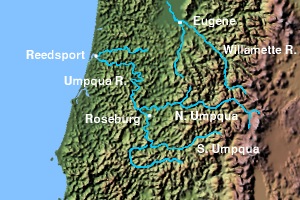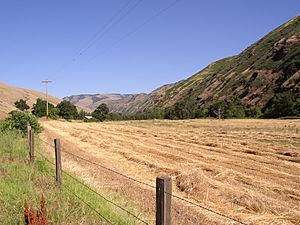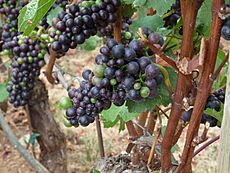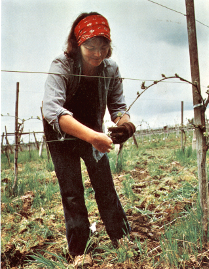Oregon wine facts for kids
| Wine region | |
| Official name | State of Oregon |
|---|---|
| Type | U.S. state |
| Years of wine industry | 1965–present |
| Country | United States |
| Sub-regions | Applegate Valley AVA, Chehalem Mountains AVA, Columbia Gorge AVA, Columbia Valley AVA, Dundee Hills AVA, Elkton Oregon AVA, Eola-Amity Hills AVA, Laurelwood District AVA, McMinnville AVA, Red Hill Douglas County, Oregon AVA, Ribbon Ridge AVA, The Rocks District of Milton-Freewater AVA, Rogue Valley AVA, Snake River Valley AVA, Southern Oregon AVA, Tualatin Hills AVA, Umpqua Valley AVA, Van Duzer Corridor AVA, Walla Walla Valley AVA, Willamette Valley AVA, Yamhill-Carlton District AVA |
| Climate region | I-III (Maritime/continental/Mediterranean) |
| Total area | 98,466 square miles (255,026 km2) |
| Size of planted vineyards | Over 30,435 acres (12,317 ha) (2016) |
| No. of vineyards | 1056 (2016) |
| Grapes produced | Abouriou, Albariño, Aligoté, Arneis, Auxerrois Blanc, Baco noir, Barbera, Black Muscat, Blaufränkisch, Cabernet Franc, Cabernet Sauvignon, Caprettone, Carménère, Cayuga, Chardonnay, Chasselas, Chenin blanc, Coda di Volpe, Counoise, Dolcetto, Early Muscat, Ehrenfelser, Fiano, Frontenac, Gamay noir, Gewurztraminer, Graciano, Grenache, Grenache blanc, Gruner Veltliner, Huxelrebe, Kerner, La Crosse, La Crescent, Lagrein, Leon Millot, Malbec, Marechal Foch, Malvasia, Marquette, Marsanne, Melon, Merlot, Mondeuse noire, Montepulciano, Mourvèdre, Muller Thurgau, Muscat Canelli, Muscat Ottonel, Nebbiolo, Niagara, Petit Verdot, Pinot blanc, Pinot gris, Pinot Meunier, Pinot noir, Pinotage, Riesling, Petit Manseng, Petite Sirah, Roussanne, Sangiovese, Sauvignon blanc, Scheurebe, Sémillon, Seyval_blanc, St. Croix, St. Laurent, Sylvaner, Syrah, Tannat, Tempranillo, Teroldego, Tinta Amarela, Tinta Cao, Tocai Friulano, Touriga Nacional, Traminette, Trousseau, Verdejo, Vermentino, Vignoles, Viognier, Zinfandel |
| Varietals produced | 82 |
| No. of wineries | 725 (2016) |
The state of Oregon in the United States is famous for making wine. It ranks fourth in the country for wine production. Only California, Washington, and New York make more.
Oregon has many different areas perfect for growing grapes. Some of these areas are entirely within Oregon. Other areas cross the border into Washington and Idaho. People started making wine in Oregon way back in the 1840s. But commercial wine production, meaning selling it as a business, began in the 1960s.
Special wine regions called American Viticultural Areas (AVAs) are found in Oregon. The Willamette Valley AVA and the Southern Oregon AVA are fully inside the state. Parts of the Columbia Gorge, Walla Walla Valley, and Snake River Valley AVAs also extend into Oregon. The top two grapes grown are Pinot noir and Pinot gris. In 2016, over 59,452 short tons (53,934 t) of these grapes were harvested. Oregon winemakers sold almost 3.4 million cases of wine that year.
With 725 wineries in Oregon, many people visit to taste wine. A lot of this tourism happens in the Yamhill Valley. This area is southwest of Portland. In 2013, wine tourism brought in about $207.5 million to Oregon's economy. This amount does not even include the money from wine sales at the wineries.
Contents
History of Oregon Wine
People have made wine in Oregon since the 1840s. This was when the Oregon Territory was first settled. However, making wine became a big business only in the 1960s. The very first grapes were planted in Oregon in 1847. The first official winery, Valley View, was started by Peter Britt in the late 1850s. This was in Jacksonville.
Throughout the 1800s, people tried growing different types of grapes. In 1904, an Oregon winemaker even won an award at the St. Louis World's Fair. But then, during Prohibition, making and selling alcohol became illegal in the United States. This stopped wine production in Oregon for 30 years.
The Oregon wine industry began to grow again in the 1960s. Winemakers from California started new vineyards in the state. By 1970, Oregon had five commercial wineries. They had about 35 acres of grapes planted.
One important step was planting Pinot noir grapes in the Willamette Valley. Many thought this area was too cold for these grapes. In the 1970s, more winemakers moved to Oregon. They started to work together as an industry. Oregon's land laws helped protect rural hillsides from being built on. This saved a lot of land for vineyards.
In 1979, The Eyrie Vineyards entered their 1975 Pinot noir in a big competition. It was called the Wine Olympics. This wine was ranked among the best Pinot noirs in the world. This brought Oregon its first international fame for wine.
Oregon wines continued to win awards in the 1980s. More wineries and vineyards opened. The state's wine industry worked hard to promote itself. They created the first of several AVAs. Oregon also built strong connections with the Burgundy region in France. Oregon's governor even visited Burgundy. A leading French winemaking family also bought land in Dundee.
In the early 1990s, tiny insects called Phylloxera threatened the vineyards. But winemakers quickly used special rootstocks that resist these pests. This prevented serious damage. The state government also passed new laws to help wine production and sales. Oregon also became known for "green" winemaking. This meant using environmentally friendly practices. By 2005, Oregon had 314 wineries and 519 vineyards. By 2014, the number of wineries grew to 676. This made Oregon the 3rd most winery-rich state. It remains the 4th largest wine producer by cases.
Types of Oregon Wine Grapes
Oregon wines are usually named after the type of grape they are made from. Oregon law says that most wines must contain at least 90% of that grape variety. For example, a Pinot noir wine must be 90% Pinot noir grapes.
There are some exceptions to this 90% rule. These include certain types of Bordeaux and Rhône wines, Sangiovese, Tempranillo, Zinfandel, and Tannat. For these wines, they only need to follow the federal rule of 75%. Oregon is most famous for its Pinot noir wine. This grape is grown all over the state. Pinot noirs from the Willamette Valley are especially praised by wine experts. Oregon is considered one of the best places in the world to grow Pinot noir.
In 2016, the top five grape varieties grown in Oregon were:
- Pinot noir with 17,744 acres (7,181 ha) planted, yielding 45,851 short tons (41,595 t) of grapes.
- Pinot gris with 3,705 acres (1,499 ha) planted, yielding 13,601 short tons (12,339 t) of grapes.
- Chardonnay with 1,482 acres (600 ha) planted, yielding 4,359 short tons (3,954 t) of grapes.
- Riesling with 713 acres (289 ha) planted, yielding 3,095 short tons (2,808 t) of grapes.
- Cabernet Sauvignon with 626 acres (253 ha) planted, yielding 1,652 short tons (1,499 t) of grapes.
Other grapes grown in Oregon include Syrah, Merlot, Tempranillo, Pinot blanc, Gewürztraminer, Viognier, and Cabernet franc. Oregon also makes other types of wine. These include fruit wine, sparkling wine, late harvest wine, ice wine, and dessert wine.
Facts and Figures About Oregon Wine
Oregon's wine industry has grown a lot. In 2015, Oregon had 702 wineries and 1052 vineyards. They grew grapes on 28,034 acres (11,345 ha) of land. Oregon ranks third in the U.S. for the number of wineries. It is fourth in total wine production.
Almost 3 million cases of Oregon wine were sold in 2015. The total sales value was over $470 million. This was a 9% increase from the year before. The wine industry has a big impact on Oregon's economy. It adds about $3.35 billion to the state's economy. Over 17,100 people work in the wine industry. Their wages total $527 million. In 2014, 70% of Oregon wine was sold outside Oregon. About 4% was sold to other countries.
Oregon makes wine on a smaller scale compared to California. Oregon's largest wine producer, King Estate, ships about 401,400 cases each year. Most Oregon wineries produce less than 35,000 cases. Many are small wineries that make under 5,000 cases per year. Most wineries in Oregon grow their own grapes. Some also buy grapes from other vineyards.
Oregon's wine industry focuses on higher-priced wines. Oregon grape growers earn more money per ton of grapes. They also earn more per case of wine than growers in other U.S. wine regions. Even though Oregon produces less wine, its wine sales per person are similar to New York and Washington.
Main Wine-Producing Regions
Oregon has three main wine-producing regions. These are defined by special areas called American Viticultural Areas (AVAs). Two of these AVAs are completely within Oregon. They are the Willamette Valley AVA and the Southern Oregon AVA. The third, the Columbia Gorge AVA, crosses the Columbia River. It includes land in both Oregon and Washington. However, it is mostly seen as an Oregon AVA.
Parts of the Walla Walla Valley AVA also extend into Oregon. This area is mostly in Washington. The Snake River Valley AVA is another region that crosses the border. It includes parts of Eastern Oregon and Idaho. The Southern Oregon AVA was created by joining two older regions: the Rogue Valley and the Umpqua Valley.
Willamette Valley AVA
The Willamette Valley AVA is a large wine-growing area. It covers the entire Willamette Valley. It stretches from the Columbia River in the north to south of Eugene. It goes from the Oregon Coast Range in the west to the Cascade Mountains in the east. At 5,200 square miles (13,500 km2), it is the biggest AVA in Oregon. Most of the state's wineries are here, with 545 in 2016.
The Willamette Valley has mild weather all year. Winters are cool and wet, and summers are warm and dry. Extreme temperatures are rare. Most rain falls outside the growing season. Not all parts of the valley are good for growing grapes. Most wineries are west of the Willamette River. The largest group is in Yamhill County.
This region is best known for its Pinot noir wine. It also produces a lot of Pinot gris, Chardonnay, Pinot blanc, and Riesling. Smaller amounts of Cabernet Sauvignon, Gewürztraminer, Müller-Thurgau, Sémillon, and Zinfandel grapes are also grown.
The Willamette Valley is divided into several smaller AVAs. These include Chehalem Mountains AVA, Dundee Hills AVA, Eola-Amity Hills AVA, Laurelwood District AVA, McMinnville AVA, Tualatin Hills AVA, Van Duzer Corridor AVA, and the Yamhill-Carlton District AVA.
Southern Oregon AVA
The Southern Oregon AVA was created in 2004. It combines two existing AVAs: the Rogue Valley AVA and the Umpqua Valley AVA. This was done to help these regions market their wines together.
Umpqua Valley AVA
The Umpqua Valley AVA includes the area around the Umpqua River. It has a warmer climate than the Willamette Valley. But it is cooler than the Rogue Valley to the south. This is Oregon's oldest wine region since Prohibition ended. Grapes grown here include Tempranillo, Baco noir, Pinot noir, Pinot gris, Cabernet Sauvignon, Chardonnay, and Riesling. The region has two smaller AVAs: the Red Hill Douglas County, Oregon AVA and the Elkton Oregon AVA.
Rogue Valley AVA
The Rogue Valley AVA includes the area around the Rogue River. It also includes its smaller rivers like the Applegate River. Most wineries here are along these smaller rivers. The region is about 70 miles (110 km) wide and 60 miles (100 km) long. There are 32 wineries with 1,100 acres (445 ha) of grapes planted.
The three river valleys in this region have different climates. The eastern Bear Creek valley is the warmest and driest. The western Illinois River valley is the coolest and wettest. Each valley grows different types of grapes. Overall, this region is the warmest and driest of Oregon's wine areas. The region has one smaller AVA, the Applegate Valley AVA.
Columbia Gorge AVA
The Columbia Gorge AVA is located in the Columbia River Gorge. This region crosses the Columbia River. So, it is in both Oregon and Washington. It includes counties like Hood River in Oregon.
This region is east of Mount Hood and Mount Adams. It is in their "rain shadow," meaning it gets much less rain than the Willamette Valley. The gorge's geography means there are big differences in elevation. Strong winds are also common. These factors allow many different types of grapes to grow here. The region has almost 40 vineyards. They grow grapes like Syrah, Pinot noir, Chardonnay, Gewürztraminer, Zinfandel, Cabernet Sauvignon, Pinot gris, and Riesling.
Columbia Valley AVA
Parts of northeastern Oregon are part of the Walla Walla Valley AVA. This area is near Milton-Freewater. The Walla Walla Valley AVA is part of the larger Columbia Valley AVA. Both of these AVAs are mostly in Washington state. The Oregon part of this region has 5 wineries. They have 1,200 acres (486 ha) of grapes planted. Wines grown here include Syrah, Merlot, and Cabernet Sauvignon.
A new smaller AVA, The Rocks District of Milton–Freewater, was created in 2015.
Snake River Valley AVA
A new wine region along the Snake River was created in 2007. It is mostly in Idaho. But it also includes two large counties in Eastern Oregon: Baker County and Malheur County. The climate here is unique for Oregon AVAs. It has cooler average temperatures and low rainfall. This creates a shorter growing season. Grapes like Riesling, Gewürztraminer, and Chardonnay grow well here. The climate is also great for making ice wine. However, this AVA is very large. Some warmer areas within it can also grow grapes like Cabernet Sauvignon and Merlot.
Visiting Oregon Wineries (Enotourism)
As Oregon's wine reputation grows, visiting wineries has become a big business. Selling wine directly at the wineries is very important. Other businesses that help wine tourists have also appeared. These include hotels, nice restaurants, and art galleries. Many of these are in places like Dundee, which used to be just farming towns. Wine festivals and tasting events are very common.
It is estimated that wine tourism brought in $207.5 million to Oregon's economy in 2013. This does not include wine sales at the wineries. About 1.8 million people visit Oregon wineries each year. Most of these visitors (59%) are from Oregon. The rest (41%) are from other states.
Big events that attract many tourists include the International Pinot Noir Celebration. This event has been held every July since 1987. There is also the newer Oregon Chardonnay Celebration.
Many wine events help bring tourists to Oregon.
- On Memorial Day weekend and Thanksgiving weekend, most wineries across the state have open house events. This has been happening since 1983.
- ¡Salud! is a group that raises money for wine workers. They have held yearly auctions in November since 1991.
- The Oregon Wine Experience is another annual event.
Compared to California wine regions like Napa Valley AVA, Oregon's wine tourism facilities are still developing. Only 5% of overnight leisure trips in Oregon include winery visits. In California, this number is much higher, from 10% to 25%.
The increase in wine tourism has affected roads in the Willamette Valley. Oregon Route 99W, a main highway through wine country, often has traffic jams. A new bypass road is being built to help with this traffic.
Organizations that Help Oregon Wine
Many groups have been created to promote Oregon Wine. Every February, the Oregon Wine Board and Oregon Wine Grower's Association hold the Oregon Wine Symposium.
Statewide organizations include:
- Oregon Beer and Wine Distributors Association: This group represents companies that distribute beer and wine in Oregon.
- Oregon Pinot Camp: This event invites wine professionals to learn about Oregon Pinot Noir. This helps them better sell Oregon wines.
- Oregon Pinot Gris: This group focuses on marketing Pinot gris wine. Nine Oregon wineries created it in 2011.
- Oregon Wine Board: This is a state agency that helps market, research, and educate about Oregon wine.
- Oregon Wine Grower's Association: This group works to protect and support its members' investments.
- Oregon Wine Press: This is a monthly magazine and online publication that supports the wine industry.
- Steamboat Pinot Noir Conference: This yearly event started in 1980. Winemakers meet to share information about growing Pinot noir grapes and making Pinot noir wine.
Regional organizations, often linked to specific AVAs, include:
- Applegate Valley Wine Trail: Supports 17 wineries.
- Chehalem Mountain Winegrowers Association: Supports 67 vineyards and wineries.
- Columbia Gorge Winegrowers: Supports wineries from both Oregon and Washington in the Columbia Gorge.
- Dundee Hills Winegrowers Association: Supports 41 wineries in the Dundee Hills AVA.
- Heart of Willamette Wineries: Supports 18 wineries between Salem and Junction City.
- McMinnville Foothills Winegrowers: Supports 8 vineyards and wineries in the McMinnville AVA.
- North Willamette Vintners: Brings together wineries, vineyards, and tourism partners in the North Willamette wine region.
- Ribbon Ridge Winegrower's Association: Supports 20 vineyards and wineries in the AVA.
- Rogue Valley Winegrowers Association: Supports more than 40 wineries in the Rogue Valley.
- South Willamette Wineries Association: Has 20 wineries around Eugene.
- Southern Oregon Winery Association: Supports over 150 wineries across four AVAs.
- Umpqua Valley Wineries: Has 23 wineries in the Umpqua Valley AVA.
- Willamette Valley Wineries Association: Started in 1986 with 11 members. Now has 215 members.
- Willamette Valley Visitors Association: Promotes the region with their popular Oregon Wine Country website.
- Yamhill-Carlton Winegrowers Association: Had 64 vineyard members in August 2016.
Awards and Praises for Oregon Wine
Oregon wines have won many important awards and received praise from famous wine critics.
- In 1904, Ernest Reuter, a winemaker from Forest Grove, won a silver medal at the St. Louis World's Fair.
- In 1979, Eyrie Vineyards' 1975 South Block Pinot noir was ranked among the top 10 Burgundy-style wines at the Gault-Millau French Wine Olympiades. It was even rated the top Pinot noir.
- Oregon wines won two gold medals at the International Wine Competition in London in 1982.
- A Yamhill Valley Vineyards 1983 Pinot noir won first place in a competition against French Burgundy wines in New York City in 1985.
Other Recognition
- In 2015, Evening Lands's 2012 Eola-Amity Hills Seven Springs Vineyard La Source Pinot Noir scored 98 points. It was #3 on Wine Spectator's annual Top 100 Wines list. Five other Oregon wines also made the list that year.
- Beaux Freres The Upper Terrace 2012 received a score of 97 from Wine Spectator. This was the second-highest score ever for an Oregon wine.
- In 2006, seven Oregon wines made Wine Spectator's annual Top 100 Wines list.
Notable Wineries and Vineyards
Here is a list of some well-known wineries and vineyards in Oregon. This includes both current and past operations.
| Name | Location | Started | Notes |
|---|---|---|---|
| Adelsheim Vineyard | Chehalem Mountains AVA | 1971 | The first winery in the Chehalem Mountains. David Adelsheim has been very important to the Willamette Valley wine industry. |
| Domaine Drouhin | Dundee Hills AVA | 1988 | A famous French wine company invested in Oregon. |
| The Eyrie Vineyards | McMinnville (winery) Dundee Hills AVA (vineyards) |
1966 | David Lett of The Eyrie Vineyards is often called the "father" of Oregon Pinot Noir. |
| HillCrest Vineyards | Umpqua Valley AVA | 1961 | Oregon's oldest winery that grows its own grapes. |
| Honeywood Winery | Willamette Valley AVA | 1934 | The oldest winery in Oregon that has been open without stopping. |
| Ponzi Vineyards | Chehalem Mountains AVA | 1970 | Dick and Nancy Ponzi are known as pioneers and leaders in Oregon winemaking. |
| Sokol Blosser Winery | Dundee Hills AVA | 1971 | Known for being environmentally friendly. |
| Willamette Valley Vineyards | Willamette Valley AVA | 1983 | The only winery in Oregon whose shares can be bought and sold by the public. |
See also
 In Spanish: Vino de Oregón para niños
In Spanish: Vino de Oregón para niños








